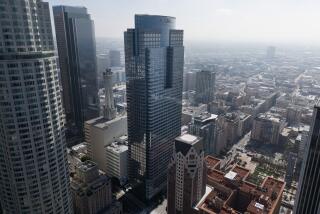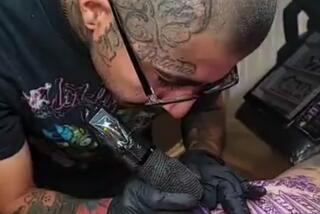An Icon Restored, Reopened
The Watts Towers, a Los Angeles icon of modern art, reopened Friday after a seven-year, $1.9-million seismic retrofitting and restoration after the Northridge earthquake.
A lighting ceremony and speeches by Mayor James K. Hahn and other dignitaries marked the reopening Friday, with community festivals planned for the weekend. The spiraling towers will be open for half-hourly tours six days a week.
Built between 1921 and 1955 by unschooled Italian immigrant Simon Rodia, the 17 structures of rebar and scrap steel are lashed together with wire, wrapped in wire mesh, coated with concrete and decorated with rocks, glazed tiles, broken pottery, seashells and shards of colored glass bottles.
Rodia, who died in 1965, completed all the work alone in his spare time, without bolts, rivets or welds. He used no scaffolding, climbing as high as 100 feet with tools attached to a belt and building materials in a bucket or burlap bag.
The towers’ tortured history includes efforts by the city to tear them down as a hazard, a successful 10,000-pound stress test organized by supporters in 1959 to prove their strength, and the ravages of time, storms and quakes.
But now, painstakingly repaired with Federal Emergency Management Agency earthquake repair funds, the towers are ready, Watts and city leaders hope, to draw visitors from around the world and revitalize a depressed community.
The once-disparaged monument is now acclaimed by experts.
Stephanie Barron, chief curator of modern and contemporary art at the Los Angeles County Museum of Art, called the Watts Towers “a remarkable, original icon of modern sculpture.”
“The fact is, this work of a self-taught artist speaks to people from all walks of life,” she said. “It has been internationally recognized and images of it have been included in important exhibitions worldwide. It continues to serve as an inspiration to artists and to visitors alike.”
But even 35 years ago the work was recognized. After Rodia’s death, Italian sculptor Gio Pomodoro proclaimed: “Hail to the innocent Gaudi of California, who destroyed the myths of Disneyland and movie-land in a swift, isolated competition.”
Despite the acclaim, and the investment by FEMA, permanent maintenance funding for the towers remains in doubt. A $384,000 state appropriation, however, provides an interim solution, and there will be a $1.50 charge for each person to tour the site.
Hahn noted that his father, former county Supervisor Kenneth Hahn, lived in South Los Angeles and used to see Rodia working on the towers as he walked through that neighborhood.
In fact, he said, the senior Hahn had tried to pacify neighbors who complained of the noise Rodia made working late at night, cracking decorative materials and breaking glass for the towers.
Also speaking at the Friday morning ceremony was the Italian consul-general in Los Angeles, Massimo Rosignio, who called the reopening “an extraordinarily meaningful event.” Rodia’s work, he said, symbolized “a source of strength to America: the contributions of foreign immigrants.”
The site is the repository of many legends, some of which were remembered Friday.
Some recalled that Rodia, an eccentric man, buried his 1928 Hudson automobile nearby. He was afraid the police were seeking it because he had used a siren on it when he was late for work as a day laborer.
In 1998, city crews building an outdoor amphitheater next to the towers retrieved the rusted remains of the car.
The seismic retrofitting done in recent years anchored the towers better, using 16-foot steel beams. Despite the 1959 test proving the structure’s resilience, Rodia had provided only an 18-inch foundation, and the Northridge quake damaged it.
*
Times staff writer Cecilia Rasmussen contributed to this report.
More to Read
Sign up for Essential California
The most important California stories and recommendations in your inbox every morning.
You may occasionally receive promotional content from the Los Angeles Times.










